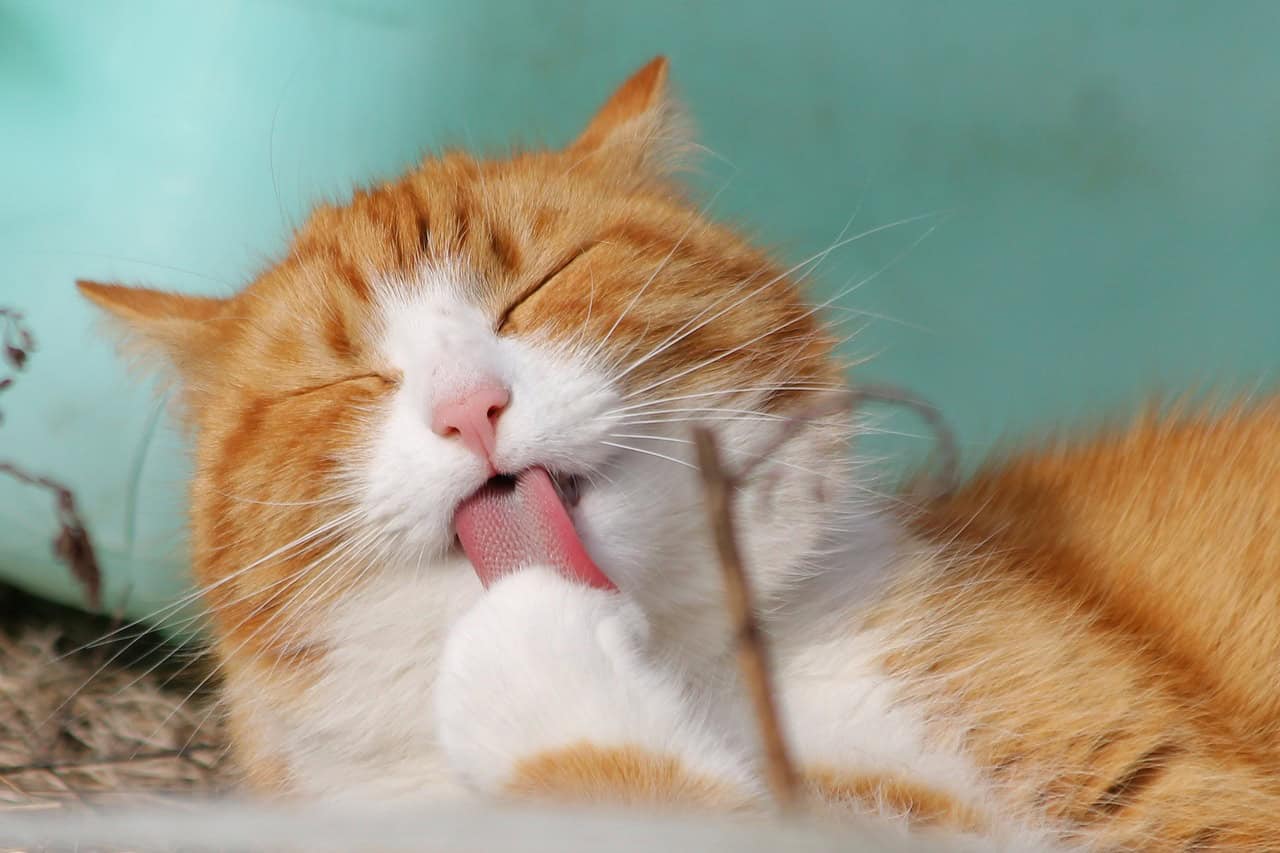Cat Grooming 101
Posted by Lora Shaw on March 28, 2018

Have you ever struggled to groom your cat? You’re probably laughing at the very question. After all, who hasn’t, right? If grooming makes you and your cat gloomy, then you need to read our post. We’ll explain strategies for calming anxious cats, how to hold your cat still, what to do when your cat’s fur is matted, how to avoid getting scratched, and more.
Strategies for Calming Anxious Cats During Grooming
We all know that anxious cats can create a stressful grooming session, but being patient and using the proper strategies can make the process rather seamless. Here are some of our favorite strategies for grooming anxious cats:
- Practice gradual desensitization – If your cat is new to grooming, odds are they are going to be curious about the tools you are using. One of the best ways to make them feel a bit less anxious about the tools is to let them sniff and explore them before use. Additionally, we suggest short grooming sessions to start with, then gradually increasing the duration as your cat becomes more comfortable.
- Use positive reinforcement – Try using treats, praise, or their favorite toy to reward your cat’s behavior during or after the grooming session.
- Choose the right tools – Be sure to use tools and brushes that are designed for cats. Also, you might want to try a variety of tools to see which ones your cat feels most comfortable with. After all, this will make the process a lot easier!
How Can I Hold My Cat Still for Grooming?
The best way to keep your cat still for grooming is to help them develop a positive association with the brush. So, we recommend you start out by just holding the brush while interacting with your cat. Let your cat sniff it and rub it if they want to, but don’t actually do any brushing.
After a few days, you can start stroking your cat with your hand while holding the brush. Again, you don’t want to actually brush your cat, you just want to use your hand. Once you’re finished, allow your cat to sniff the brush and then reward them with a treat or some extra petting.
In time, your cat will start to view the brush positively. Once that occurs, you can start moving it softly against your cat’s face. If your cat seems relaxed, you can even try gentle brushing along the neck or back. With time and practice, your cat will gradually get used to being groomed.
The important thing to remember is that you don’t want to rush this process. If at any time your cat seems uncomfortable, quit for the time being and slowly try again in a day or two.
How Can I Groom a Cat with Matted Fur?
To groom a cat with matted fur, you’re going to want to reach for a wide-toothed comb. Then, start working on the mat from the ends first. As you begin to untangle, keep moving closer, toward your cat’s skin. While you’re combing, remember to gently hold your cat’s skin down as you begin to work the mat out. Doing this will prevent uncomfortable, painful tugging.
If a wide-tooth comb doesn’t do the trick, you can also use something called a mat comb or razor comb. It’s a brush with recessed blades that will cut your cat’s fur while you’re brushing.
While you might be tempted to use scissors, we don’t recommend that because it’s too easy to accidentally hurt your cat.
How Can I Groom My Cat Without Being Scratched?
If your cat is especially nervous about being groomed, you might feel like scratches are inevitable. However, oftentimes a wrapped towel can help.
Simply lay a towel down flat and place a can of cat food on the towel. Once your cat lays down to eat, you can loosely wrap both sides of the towel around your cat’s back.
You can then shift the towel slightly to groom your cat’s fur while they eat. Just remember to try this process while you’re already relaxed or your cat will sense your anxiety.
Does Cat Grooming Reduce Furballs?
Absolutely! Cat grooming prevents hairballs by reducing the amount of loose fur they may swallow when cleaning themselves. The loose hairs they swallow can accumulate in their stomach, which is what causes the hairballs. Brushing regularly helps remove excess fur from the cat’s coat, reducing the amount of hair they ingest.
How Does Cat Grooming Change Throughout the Year?
Similar to dogs, a cat’s coat may change throughout the year, so you might want to consider adjusting your grooming routine to accommodate this fact. This is especially helpful for outdoor cat owners!
- Spring – After the winter, your cat may shed more to prepare for the warmer months. Regular brushing can remove any loose winter fur and prevent matting. If you notice your cat sheds a lot, consider a deshedding tool that will remove excess hair and reduce the chances of hairballs. Additionally, spring is the prime season for fleas and ticks, so be sure to practice prevention and treatment as your veterinarian deems appropriate.
- Summer – By summer, your cat probably did most of their shedding and is ready to stay cool during the warmer months. Practicing regular grooming is still a great way to make them feel loved and reduce their hairballs.
- Fall – Cats begin to thicken their coat for the chilly winter months. Be aware of spots that are prone to matting, like the area behind the ears. Don’t forget about flea and tick treatments as well!
- Winter – By this point, your cat will have developed a thick coat. Monitor their shedding and check for areas of matting frequently. Groom as you deem appropriate.
How and When Should I Bathe My Cat?
Bathing a cat is not a necessary part of the grooming routine because most cats are proficient at grooming themselves. However, there are situations where a bath might be a solution, especially if your cat gets into a sticky situation, has skin issues, or is unable to groom themselves properly. Here are some reasons why you would want to consider bathing your cat:
- Medical issues – Some cats have skin conditions or are unable to groom themselves due to an illness. In either case, a vet might recommend that you bathe your cat.
- Accidents – If your cat gets into a sticky or messy situation, a bath is a quick fix that can get them feeling good as new.
- Flea treatments – Some topical flea treatments need to be applied to clean fur and skin. Be sure to follow the instructions provided with the flea treatment.
When bathing your cat, be sure to use cat-specific grooming products. There are shampoos and conditioners that are formulated specifically for feline skin and don’t contain any irritants like strong fragrances or harsh chemicals.
What Can I Do If I Still Need Help Grooming My Cat?
If you still need help grooming your cat, it’s time to call in a professional. At Pet Palace, we offer lots of pampering and TLC during grooming sessions, making your cat feel like the member of royalty it is. Learn more now about the special cat grooming services we offer at our deluxe pet spa.
Be sure to contact us with any questions!

Categories: Cats, Pet Grooming, Tips for Your Pets
Archives
Recent Articles
Categories
Monthly Archive
- July 2025
- June 2025
- May 2025
- April 2025
- March 2025
- February 2025
- January 2025
- December 2024
- November 2024
- October 2024
- September 2024
- August 2024
- July 2024
- June 2024
- May 2024
- April 2024
- March 2024
- February 2024
- January 2024
- December 2023
- November 2023
- October 2023
- August 2023
- July 2023
- June 2023
- May 2023
- April 2023
- March 2023
- February 2023
- January 2023
- December 2022
- November 2022
- October 2022
- August 2022
- July 2022
- June 2022
- April 2022
- March 2022
- February 2022
- November 2021
- October 2021
- November 2020
- September 2020
- July 2020
- March 2020
- January 2020
- November 2019
- September 2019
- July 2019
- March 2019
- January 2019
- December 2018
- November 2018
- October 2018
- August 2018
- July 2018
- June 2018
- May 2018
- April 2018
- March 2018
- February 2018
- January 2018
- December 2017
- November 2017
- October 2017
- September 2017
- August 2017
- July 2017
- June 2017
- May 2017
- April 2017
- March 2017
- February 2017
- January 2017
- December 2016
- November 2016
- September 2016
- August 2016
- July 2016
- June 2016
- May 2016
- April 2016
- March 2016
- February 2016
- December 2015
- November 2015
- October 2015
- September 2015
- August 2015
- July 2015
- May 2015
- March 2015
- February 2015
- January 2015
- December 2014
- November 2014
- September 2014
- August 2014
- July 2014
- June 2014
- May 2014
- March 2014
- February 2014
- January 2014
- December 2013
- November 2013
- October 2013
- September 2013
- August 2013
- June 2013
- May 2013
- March 2013
